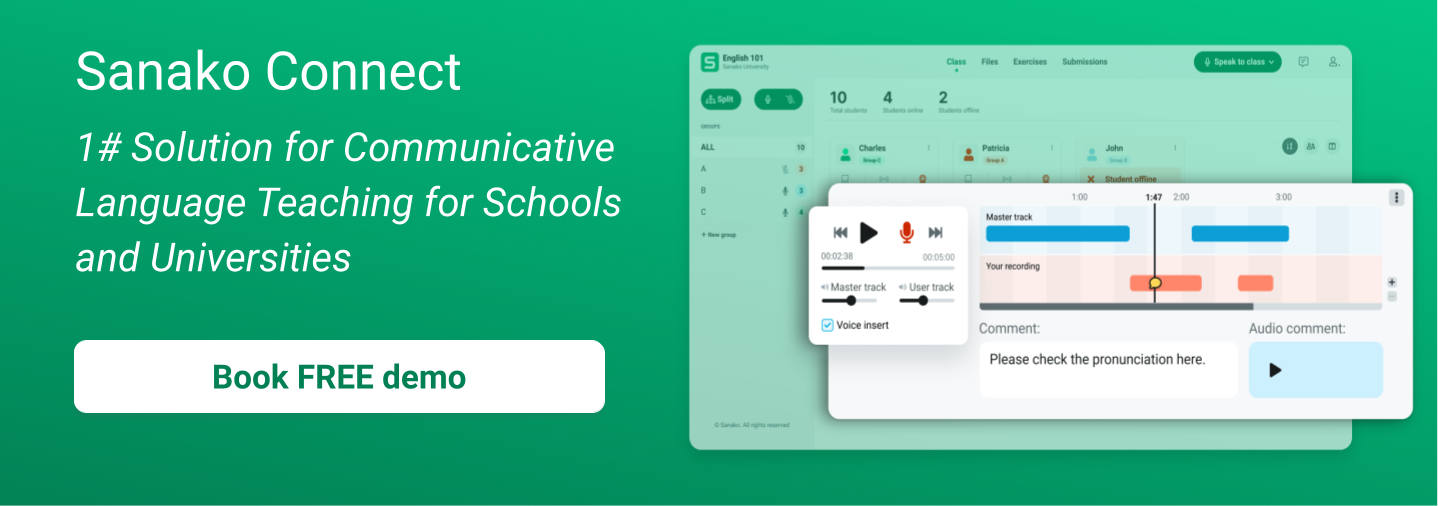Choosing and using the right teaching approach is an important consideration for all language educators. Get it right and students progress towards fluency at pace in a calm and enjoyable learning environment. But get it wrong and students can quickly become demotivated and disengaged, particularly in formal education settings where they might not have a chance to choose to take a second language based on their own motivation.
Communicative Language Teaching or CLT is widely recognised across language classrooms globally as a highly applicable and effective teaching and learning approach. But why is the CLT approach so effective and what are the advantages of the communicative language teaching approach for educators and students?
What’s the focus of Communicative Language Teaching?
The CLT approach focuses on giving students the skills to clearly and confidently communicate in real-world situations with native speakers of their target language. As such, it moves away from a traditional focus on grammar to encourage the active and authentic use of language in learning and acquisition. CLT therefore prioritises interaction and problem solving and usually involves classroom activities such as role play and pair or group work.
Author and researcher David Nunan identified five key elements to the CLT approach:
- An emphasis on learning to communicate through interaction in the target language.
- The introduction of authentic texts into the learning situation.
- The provision of opportunities for learners to focus, not only on the language but also on the learning process itself.
- An enhancement of the learner’s own personal experiences as important contributing elements to classroom learning.
- An attempt to link classroom language learning with language activation outside the classroom.
For further support on applying the CLT approach in language teaching, please see this Sanako blog post on the subject.
What are the advantages of the CLT approach to language teaching?
According to Harmer, 1988 and Savignon, 2002, the CLT approach offers many advantages for both teachers and students. These are summarised in brief below:
Learning with a purpose
Firstly, CLT delivers a clear and obvious benefit to learners – they’re actually able to use the skills they’ve learnt to communicate in their target language. CLT is not about learning just for learning’s sake, it has a clear and definable purpose. Students become competent communicators, able to use the right grammar, vocabulary and sentence structure in different real-life contexts and are flexible enough to adapt as circumstances dictate.
As such, CLT typically places less emphasis on rote learning of detailed grammatical rules in favour of gaining greater fluency in the target language. Students are assessed on their level of communicative competence rather than on their ability to regurgitate information. This approach also enables learners to quickly gain confidence when interacting with other people, which helps them enjoy using their new-found language skills.
Student-centered approach
The above advantage also help us to identify a second – that the CLT approach tends to be a more student-centred and situation-oriented language teaching practice. In fact, according to Oxford (1990), CLT deliberately emphasizes “self-direction for the learners”. Given that the teacher will not be available to help students when they’re out in the real-world, it’s appropriate that they should take the lead in developing their core language skills and find ways to prioritise communication and conversation. Oxford believes that this is: “essential to the active development of the new language.”
In this light, CLT also has a highly positive impact on the relationships between teachers, students and their peers. At the highest level, CLT requires all participants to move away from the traditional teacher / student model to be successful. In the language classroom, learners also need to engage in learning activities in a cooperative rather than individualistic manner – it’s vital that they work together to build effective conversations and to complete the pair / group tasks that are at the heart of the CLT approach. As such, teachers can develop more creative language learning activities that go beyond the traditional repetition and the memorization of sentences and grammatical patterns.
Increases student engagement
As a result, evidence suggests that the CLT approach usually increases the students’ engagement and enjoyment of their lessons. Where classroom resources and tasks are grounded in everyday situations with immediately evident, real-world application, students come alive. They become the protagonists at the centre of learning rather than the audience on the sidelines watching on (Dos Santos, 2020). Furthermore, students are also immediately able to take their learning and put it into practice in their engagement with native speakers outside of the classroom.
As well as offering clear advantages to the student, the CLT approach can also offer significant benefits to educators by fundamentally changing their role in the classroom. The educator is both a “facilitator, a guide and a helper” as well as being a “coordinator, an idea-person and a co-communicator” (Oxford, 1990). Teachers talk less and listen more as well as being more focused on students’ individual learning journeys and working closely with them to achieve their goals.
Increases lesson variability and creativity
As adopting the CLT approach usually means that traditional, repetitive Instructional tasks become less important, teachers have more scope to be creative in the classroom. Although this means that additional time is needed to prepare appropriate teaching resources, there’s significant benefit in increased student engagement and motivation.
Develops all core language skills
Finally and perhaps most importantly, CLT is a powerful teaching approach to encourage the development of the four macro skills in language learning— speaking, listening, reading and writing. These are a core part of CLT from the very start, since active communication serves to integrate the different skills. The use of authentic or real teaching materials (brochures, flyers, timetables, menus and magazines) also helps ensure that students develop relevant grammar and vocabulary while working through activities that build these core skills.
As Belchamber (2007) concludes:
“In practical terms, whether assisting mixed-ability classes, aiding motivation, leading from a focus on form to one of fluency, or supporting learning, it (CLT) has a lot to offer the EFL teacher.”
Conclusion
In this blog post, we explored the advantages of Communicative Language Teaching (CLT), a widely recognized and effective language teaching approach. The primary focus of CLT is enabling students to communicate confidently in real-world situations by engaging in authentic and interactive learning activities.
We discussed the key elements of CLT, as identified by David Nunan, which emphasize interaction, authentic texts, learner-centeredness, personal experiences, and a connection between classroom learning and language activation outside the classroom.
The advantages of CLT include learning with a clear purpose, fostering a student-centered approach, increasing student engagement, promoting lesson variability and creativity, and developing all core language skills. Teachers in a CLT classroom take on roles as facilitators, guides, and co-communicators, enhancing the learning experience for students.
Despite the numerous advantages, it’s important to consider the challenges or limitations of CLT when determining if it’s the right approach for your specific context. Overall, CLT has proven to be a valuable and versatile method for language teaching, equipping learners with practical communication skills and fostering a supportive and engaging learning environment.
Sanako’s software solutions have been specifically designed to help language educators maximise the time their students spend developing their core skills. As such, our solutions are perfectly suited to supporting CLT teaching methodologies and are used in 50,000 classrooms worldwide to develop competent and confident communicators. Book a free online demo now to see how we can help you to take your approach to Communicative Language Teaching to the next level!
This blog post was last updated 6 April, 2023.

